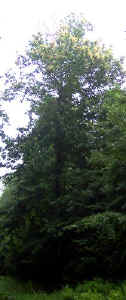
Overview of the Chestnut Tree, Height 62 feet, CBH 3.9 feet -
measurements by Dale Luthringer, photo by Ed Frank |
American Chestnut Expedition,
Brockway, PA, July 12, 2004
I awakened early, before
the alarm went off, to the sound of thunder and rain falling on
the roof. The
planned trip looked like it was off for the day as I fell back
to sleep. I
awakened again a few minutes past nine, the rain had stopped and
the sun struggled to peak through the clouds.
I jumped out of bed, at least as fast as I can at that
time of the morning, because there was still time to make the
trip. A quick
shave, a change of clothes, and I was off to meet the intrepid
Dale Luthringer at Sheetz in Falls Creek, PA.
We were off to see, photograph, and measure a particular
American Chestnut tree. I
arrived with five minutes to spare for the 9:30 meeting time.
Dale was already waiting after an early morning shift at
UPS. I bought a
Mountain Dew and we were off.
For those of you without
the background information, in 1904 an Asian fungus, the
chestnut blight, spread out across the country from an initial
source at the Bronx Zoological Garden.
The American Chestnut had little resistance to the
blight. American
Chestnuts, once was a major part of the American forest
landscapes, were virtually wiped out by the 1920’s.
Sprouts from
roots of the trees still send up shoots. There are dozens, if not hundreds of chestnut tree of shrub
height, perhaps a handful of larger ones, in the small patch of
woods behind my home. None
of them have reached reproductive maturity.
Only a handful of American Chestnuts ever reach this
state before succumbing to the blight.
The impetus for this
trip started a week previously.
There had been a full page article in the local paper-
Tri-County Sunday, dated July 4, 2004, page A2, by a
local writer named Kimberly Finnegan.
The article was entitled “American chestnut tree fight
hits area.” The
article talked about efforts in the local area by the American
Chestnut Foundation. http://www.acf.org
to try to re-establish the American Chestnut tree in this
country. There were
also a series of nice photographs taken of the efforts by Ms.
Finnegan.
The newspaper article
focused on one tree along Rattlesnake Road here in Jefferson
County, PA. This
tree is one of five locally being used by the American Chestnut
Foundation in its breeding program.
Using a bucket truck donated by a the local United
Electric Cooperative, Gary Gilmore of the Jefferson County DCNR,
and Dave Lazor of
the ACF, bagged the reproductive parts of the tree, green burrs
growing near the top of the tree, to keep them from being
pollinated. Altogether
110 burrs were bagged in the process.
They returned a second time to pollinate the burrs using
pollen from a chestnut research orchard in the Hawker Hill area
of PA. Toward the
end of September or October they will return to collect the
fertile chestnuts. The
ACF is attempting to breed resistance into the species by cross
breeding it with resistant Chinese Chestnuts.
More information about the organization is available at
the above web address and also at the Pennsylvania Chapter’s
website: http://www.patacf.org
|
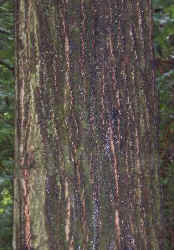
Close-up of the bark of this young, but mature American
Chestnut. |
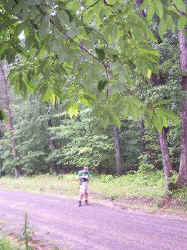
The intrepid Dale Luthringer measuring the Chestnut tree. |
|
|
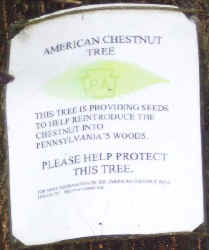
Notice placed on the tree by the American Chestnut
Foundation. |
The tree was described
as being from 80 to 100 feet high.
I had my doubts about the height as they were using a
bucket truck to reach the top of the tree, but there was a photo
of the tree’s trunk that looked to be at least 10 to 12 inches
across. This
sparked my interest. I
have seen chestnut trees as
long ago as I can remember.
Even the rustic rails around our back patio are made of
chestnut logs from trees dead for eighty years collected from
the woods behind the house, but I had never seen one “in
bloom.” I emailed
Dale about the Chestnut Tree.
There was a generalized description of the trees location
in the article, but that likely was not enough.
The Gary Gilmore in the article is someone I have met,
and a good friend of Dale’s.
Dale emailed him and we got better directions, and GPS
coordinates for the tree, and for a couple of other chestnuts of
interest in the same area.
We set the time for Dale and I to go check it out.
After getting my
Mountain Dew I hopped into Dales truck and we were off.
The American Chestnut Expedition, even though we planned
to only visit one tree, that is no reason not to have an
impressive title. We
followed the instructions and after only one missed turn, we
found the tree. It
was adjacent to the dirt road in a stand of relatively young
second growth trees. The entire top of the tree was covered with fronds.
Half of them were covered by small white bags awaiting
the pollinated flowers to grow into chestnuts.
I walked around the tree and took a series of
photographs, while Dale measured the height of the tree.
Before arriving I expected something more on the line of
45 to 50 feet, Gary Gilmore estimated 65 feet.
Dale measured the tree to be 62 feet high, an average of
two readings, and having a circumference of 3.9 feet.
After spending some time examining the tree, we headed
back to Falls Creek. It
was wet to go tramping into the woods in search of the other
chestnuts for which we had locations, the storm looked as if it
was about to refire, and I had to be at work by 11 o’clock.
We plan to check out the other trees soon.
The American Chestnut
Foundation has a form on their website in which visitors are ask
to report chestnut trees found in the wild.
There is a description explaining how to tell the
difference between American Chestnut, Chinese Chestnut, and
hybrids of the two. I
am sure they would appreciate reports of any reproductively
mature chestnuts that any of you may find in your forest
travels. I have
posted a series of pictures from the trip on the ENTS website
at:
http://www.nativetreesociety.org/galleries/chestnut/american_chestnut.htm
If the address wraps you
can select the American Chestnut gallery from the Eastern Trees
Gallery main page.
I would like to
encourage ENTS members to take photos on their various field
trips. If you do
not want to attach them to the posts to the newsgroup because of
size considerations, email them to me and I will post them, at
least temporarily on the ENTS website and you can refer to this
gallery in your field trip post.
Ed Frank |
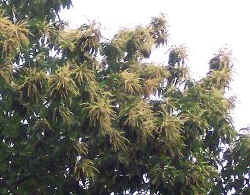 |
|
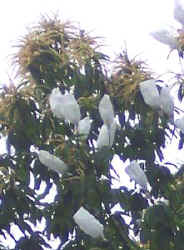
|
|
|
|
|